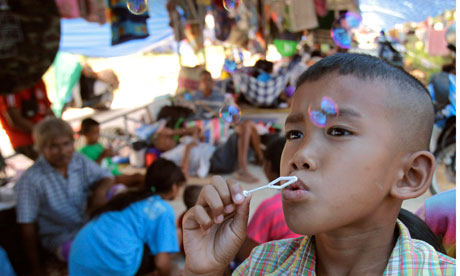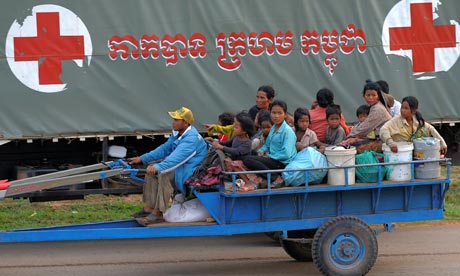At least 16 dead in violence that has caused nearly 100,000 villagers to flee disputed area
A Thai child who fled clashes between Thai and Cambodian soldiers at an evacuation center in Surin province, northeastern Thailand. Photograph: Wason Wanichakorn/AP
Thai and Cambodian troops broke a brief ceasefire and clashed for an eighth day, shattering hopes of a quick end to a long-running border conflict that has forced nearly 100,000 villagers to flee. The death toll rose to 16.
Fighting erupted in the morning and again briefly on Friday night, both countries' troops said, as displaced residents on each side waited to see if the worst skirmishes in years might finally end.
"I wish both sides could talk, so that there is no more fighting," said Boonteung Somsed, a Thai construction worker who fled to the village of Prasat, about 20 miles from the border. "Every time a soldier picks up a weapon, a village has to run away from home."
"We cannot trust the Thais," he said. "Yesterday they said they'd stop fighting and now they are attacking us again."
Thai army spokesman Colonel Sansern Kaewkamnerd blamed Cambodia for breaking the deal, saying its "local units might not agree to the talks as easily as their commanders did."
He told reporters in Bangkok the Thai army sent a 10-member delegation of middle-ranking officers across the border ito meet their Cambodian counterparts again. "The first step is to sustain the truce, then we can take further steps for talks," he said.
The director of Phanom Dongrak hospital, about 12 miles from the border, confirmed one Thai soldier was killed late Thursday, bringing the total dead to 15 soldiers and one civilian.
Thai authorities say the fighting has uprooted 51,000 people from their homes while Cambodia's Red Cross says more than 45,000 people there have fled over the past week.
"I want both countries to stop fighting, so that I can go home," said Saman Yingnaram, 37, a farmer in Prasat. "My cassava field will be sabotaged (by insects) by the time I return."
On Thursday, Indonesian Foreign Minister Marty Natalegawa said his Thai counterpart had agreed to allow Indonesian observers, but there was no word on when they would arrive. Cambodia had already agreed to the deployment.
Indonesia, which currently chairs the Association of Southeast Asian Nations, offered to provide the observers after the last round of fighting in February.
Few believe the conflict will lead to full-scale war and neither side appears to be trying to capture territory.
Some believe Thailand's military fears the possible outcome of elections expected in June or July and is trying to rally Thais behind it. Thai media have suggested Cambodia's Hun Sen, who has been in power since 1985, was fomenting border tensions to distract his public
Fighting erupted in the morning and again briefly on Friday night, both countries' troops said, as displaced residents on each side waited to see if the worst skirmishes in years might finally end.
"I wish both sides could talk, so that there is no more fighting," said Boonteung Somsed, a Thai construction worker who fled to the village of Prasat, about 20 miles from the border. "Every time a soldier picks up a weapon, a village has to run away from home."
Thailand and Cambodia have clashed six times since 2008 over the border, where several crumbling Hindu temples built nearly 1,000 years ago during the Khmer Empire sit atop cliffs and in jungles mined in wars past. The land has been disputed for more than half a century, but analysts say domestic politics on both sides are driving the conflict as much as any real disagreement between the countries.
Field commanders agreed to the brief truce on Thursday in a meeting at the disputed border. But a Cambodian colonel, Suos Sothea, said the Thai army again fired artillery shells into Cambodia early Friday and small arms fire crackled again around the Ta Krabey temple, which is in a disputed area."We cannot trust the Thais," he said. "Yesterday they said they'd stop fighting and now they are attacking us again."
Thai army spokesman Colonel Sansern Kaewkamnerd blamed Cambodia for breaking the deal, saying its "local units might not agree to the talks as easily as their commanders did."
He told reporters in Bangkok the Thai army sent a 10-member delegation of middle-ranking officers across the border ito meet their Cambodian counterparts again. "The first step is to sustain the truce, then we can take further steps for talks," he said.
The director of Phanom Dongrak hospital, about 12 miles from the border, confirmed one Thai soldier was killed late Thursday, bringing the total dead to 15 soldiers and one civilian.
Thai authorities say the fighting has uprooted 51,000 people from their homes while Cambodia's Red Cross says more than 45,000 people there have fled over the past week.
"I want both countries to stop fighting, so that I can go home," said Saman Yingnaram, 37, a farmer in Prasat. "My cassava field will be sabotaged (by insects) by the time I return."
On Thursday, Indonesian Foreign Minister Marty Natalegawa said his Thai counterpart had agreed to allow Indonesian observers, but there was no word on when they would arrive. Cambodia had already agreed to the deployment.
Indonesia, which currently chairs the Association of Southeast Asian Nations, offered to provide the observers after the last round of fighting in February.
Few believe the conflict will lead to full-scale war and neither side appears to be trying to capture territory.
Some believe Thailand's military fears the possible outcome of elections expected in June or July and is trying to rally Thais behind it. Thai media have suggested Cambodia's Hun Sen, who has been in power since 1985, was fomenting border tensions to distract his public








